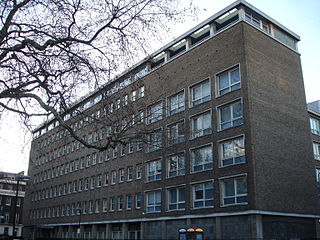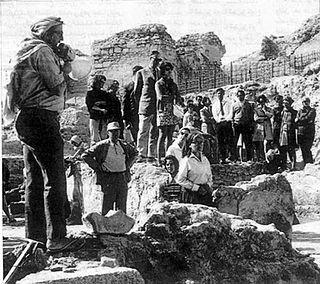Related Research Articles
University College London is a public research university in London, England. It is a member institution of the federal University of London, and is the second-largest university in the United Kingdom by total enrolment and the largest by postgraduate enrolment.

A ziggurat is a type of massive structure built in ancient Mesopotamia. It has the form of a terraced compound of successively receding storeys or levels. Notable ziggurats include the Great Ziggurat of Ur near Nasiriyah, the Ziggurat of Aqar Quf near Baghdad, the now-destroyed Etemenanki in Babylon, Chogha Zanbil in Khūzestān and Sialk. The Sumerians believed that the gods lived in the temple at the top of the ziggurats, so only priests and other highly-respected individuals could enter. Sumerian society offered these individuals such gifts as music, harvested produce, and the creation of devotional statues to entice them to live in the temple.

Ziusudra of Shuruppak is listed in the WB-62 Sumerian King List recension as the last king of Sumer prior to the Great Flood. He is subsequently recorded as the hero of the Eridu Genesis and appears in the writings of Berossus as Xisuthros.

In Mesopotamian religion, Tiamat is the primordial sea, mating with Abzû (Apsu), the groundwater, to produce the gods in the Babylonian epic Enûma Elish, which translates as "When on High". She is referred to as a woman, and has, at various points in the epic, both anthropomorphic and theriomorphic features including breasts and a tail.

Dilmun, or Telmun, was an ancient East Semitic-speaking civilization in Eastern Arabia mentioned from the 3rd millennium BC onwards. Based on contextual evidence, it was located in the Persian Gulf, on a trade route between Mesopotamia and the Indus Valley civilisation, close to the sea and to artesian springs. Dilmun encompassed Bahrain, Kuwait, and eastern Saudi Arabia. This area is certainly what is meant by references to "Dilmun" among the lands conquered by King Sargon II and his descendants.

UCL's Institute of Archaeology is an academic department of the Social & Historical Sciences Faculty of University College London (UCL) which it joined in 1986 having previously been a school of the University of London. It is currently one of the largest centres for the study of archaeology, cultural heritage and museum studies in the world, with over 100 members of staff and 600 students housed in a 1950s building on the north side of Gordon Square in the Bloomsbury area of Central London.

The Petrie Museum of Egyptian Archaeology in London is part of University College London Museums and Collections. The museum contains 80,000 objects, making it one of the world's largest collections of Egyptian and Sudanese material. It is designated under the Arts Council England Designation Scheme as being of "national and international importance".

Sir Henry Peter Francis Swinnerton-Dyer, 16th Baronet, was an English mathematician specialising in number theory at the University of Cambridge. As a mathematician he was best known for his part in the Birch and Swinnerton-Dyer conjecture relating algebraic properties of elliptic curves to special values of L-functions, which was developed with Bryan Birch during the first half of the 1960s with the help of machine computation, and for his work on the Titan operating system.

Sir Charles Waldstein, known as Sir Charles Walston from 1918 to 1927, was an Anglo-American archaeologist. He also competed at the 1896 Summer Olympics in Athens.

Pre-Islamic Arabia, referring to the Arabian Peninsula before Muhammad's first revelation in 610 CE, is referred to in Islam in the context of jahiliyyah, highlighting the prevalence of paganism throughout the region at the time.

Eastern Arabia, is a region stretched from Basra to Khasab along the Persian Gulf coast and included parts of modern-day Bahrain, Iraq, Kuwait, Oman, Qatar, Saudi Arabia, and the United Arab Emirates. The entire coastal strip of Eastern Arabia was known as "Bahrain" for a millennium.
Eleanor Robson, is a British Assyriologist and academic. She is Professor of Ancient Middle Eastern History at University College London. She is a former chair of the British Institute for the Study of Iraq and a Quondam fellow of All Souls College, Oxford. She is a Fellow of the British Academy.
Stephen Shennan, FBA is a British archaeologist and academic. Since 1996, he has been Professor of Theoretical Archaeology. He was Director of the Institute of Archaeology at the University College London from 2005 to 2014.
Ruth Marion Lynden-Bell, FRS is a British chemist, emeritus professor of Queen's University Belfast and the University of Cambridge, and acting President of Murray Edwards College, Cambridge from 2011 to 2013.

Thomas Geoffrey Bibby was an English-born archaeologist. He is best known for discovering the ancient state of Dilmun, referred to in Mesopotamian mythology as a paradise. He is often considered to have been the pioneer of Arabian archaeology.

The Qal'at al-Bahrain, also known as the Bahrain Fort or Portuguese Fort, is an archaeological site located in Bahrain. Archaeological excavations carried out since 1954 have unearthed antiquities from an artificial mound of 12 m (39 ft) height containing seven stratified layers, created by various occupants from 2300 BC up to the 18th century, including Kassites, Greeks, Portuguese and Persians. It was once the capital of the Dilmun civilization and was inscribed as a UNESCO World Heritage Site in 2005.

Sue Hamilton is a British archaeologist and Professor of Prehistory at the UCL Institute of Archaeology. A material culture specialist and landscape archaeologist, she was the UCL Institute of Archaeology's first permanent female director (2014–22).

The complaint tablet to Ea-nāṣir is a clay tablet that was sent to the ancient city-state Ur, written c. 1750 BCE. It is a complaint to a merchant named Ea-nāṣir from a customer named Nanni. Written in Akkadian cuneiform, it may be the oldest known written customer complaint. It is currently kept in the British Museum. In 2015, the tablet's content and Ea-nāṣir in particular gained popularity as an online meme.
The Sumerian economy refers to the systems of trade in ancient Mesopotamia. Sumerian city-states relied on trade due to a lack of certain materials, which had to be brought in from other regions. Their trade networks extended to places such as Oman, Arabia, Anatolia, the Indus River Valley, and the Iranian Plateau. Sumerians also bought and sold property, but land tied to the temples could not be traded. There were three types of land—Nigenna, Kurra, and Urulal—and only Urulal land could be traded; Nigenna land belonged to the temple, while Kurra land belonged to the people working in the temple. Within Sumer, the Sumerians could use silver, barley, or cattle as currency.
Ellie Hisama is a Japanese-American music theorist who is dean of the faculty of music and a professor of music at the University of Toronto. Hisama's work focuses on issues of gender, race, sexuality, and the sociology of music.
References
- 1 2 "Crawford, Harriet E. W." LC Name Authority File. Retrieved 9 August 2022.
- ↑ Morris, Susan, ed. (20 April 2020). Debrett's Peerage and Baronetage 2019. eBook Partnership. p. 438. ISBN 9781999767051.
- ↑ "Marriages". The Times. 26 May 1983. p. 20.
- ↑ Reid, Miles (9 January 2019). "Sir Peter Swinnerton-Dyer obituary". The Guardian. Retrieved 9 August 2022.
- ↑ "Ruth Whitehouse". Trowelblazers. 28 July 2021. Retrieved 9 August 2022.
- ↑ "Emeritus". 22 January 2019. Retrieved 9 August 2022.
- ↑ "Harriet Crawford". Bloomsbury Academic. Retrieved 9 August 2022.